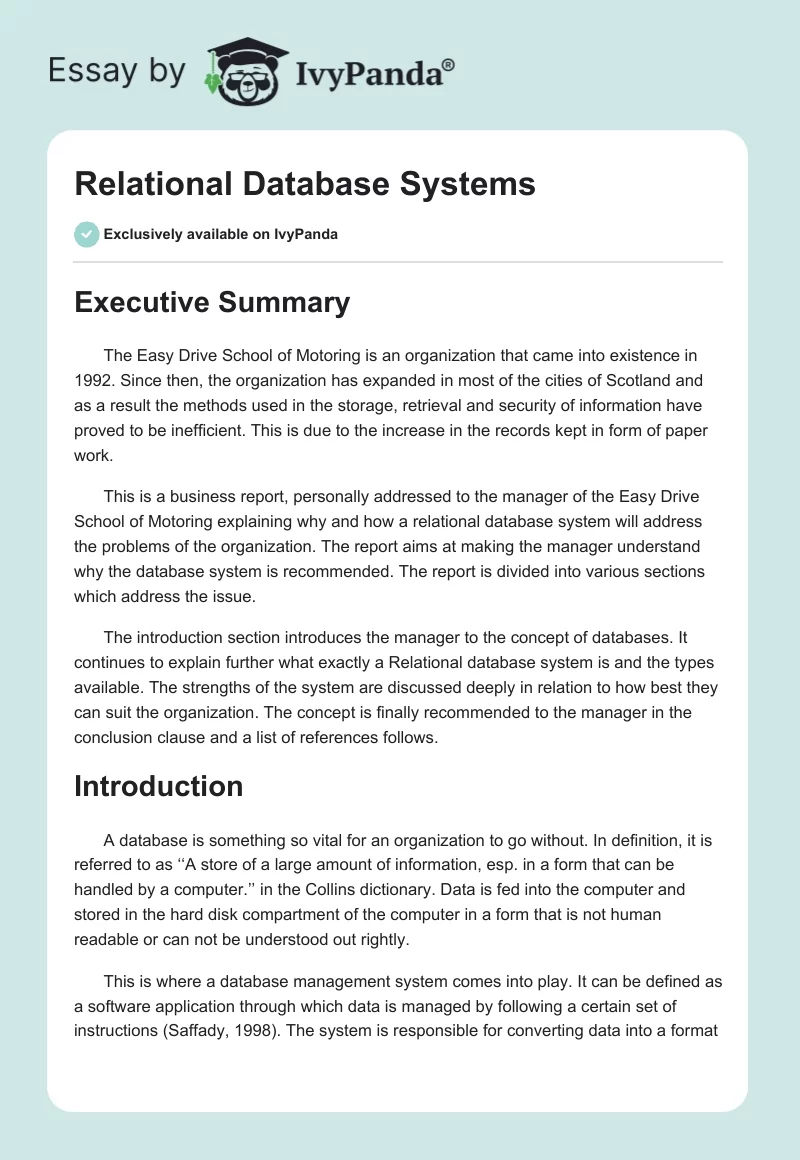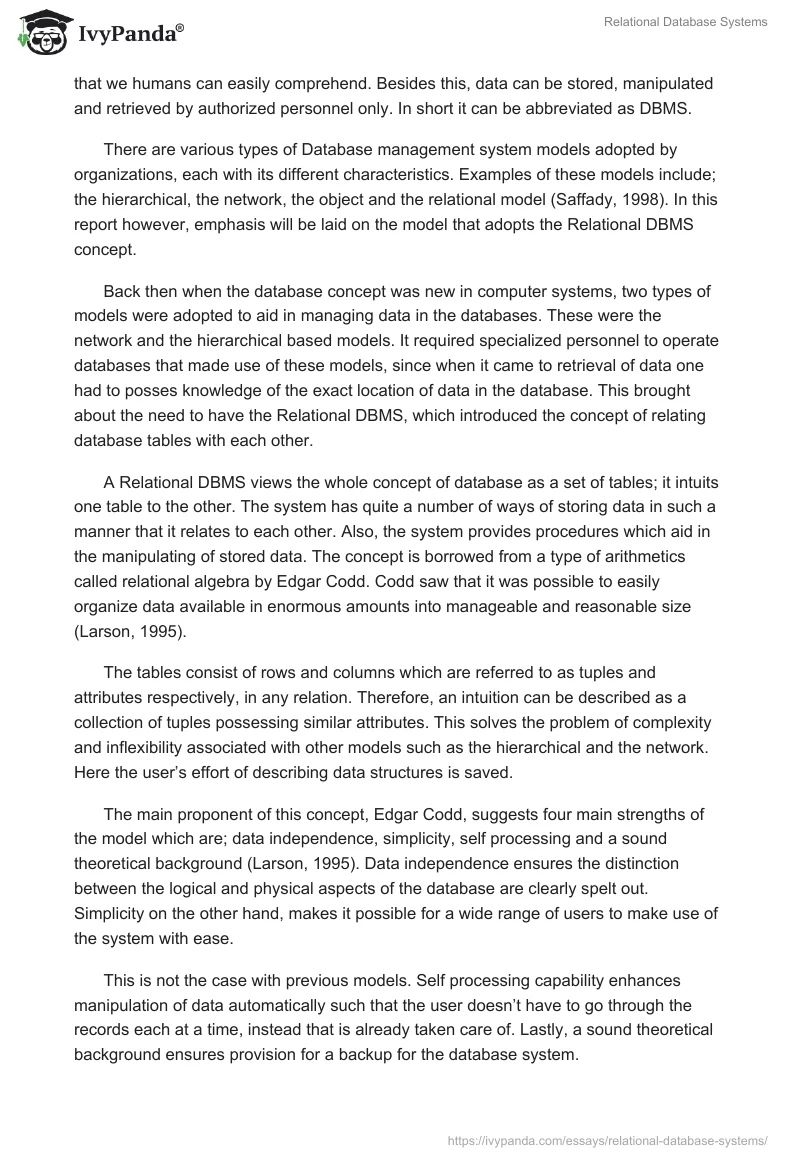Executive Summary
The Easy Drive School of Motoring is an organization that came into existence in 1992. Since then, the organization has expanded in most of the cities of Scotland and as a result the methods used in the storage, retrieval and security of information have proved to be inefficient. This is due to the increase in the records kept in form of paper work.
This is a business report, personally addressed to the manager of the Easy Drive School of Motoring explaining why and how a relational database system will address the problems of the organization. The report aims at making the manager understand why the database system is recommended. The report is divided into various sections which address the issue.
The introduction section introduces the manager to the concept of databases. It continues to explain further what exactly a Relational database system is and the types available. The strengths of the system are discussed deeply in relation to how best they can suit the organization. The concept is finally recommended to the manager in the conclusion clause and a list of references follows.
Introduction
A database is something so vital for an organization to go without. In definition, it is referred to as ‘‘A store of a large amount of information, esp. in a form that can be handled by a computer.’’ in the Collins dictionary. Data is fed into the computer and stored in the hard disk compartment of the computer in a form that is not human readable or can not be understood out rightly.
This is where a database management system comes into play. It can be defined as a software application through which data is managed by following a certain set of instructions (Saffady, 1998). The system is responsible for converting data into a format that we humans can easily comprehend. Besides this, data can be stored, manipulated and retrieved by authorized personnel only. In short it can be abbreviated as DBMS.
There are various types of Database management system models adopted by organizations, each with its different characteristics. Examples of these models include; the hierarchical, the network, the object and the relational model (Saffady, 1998). In this report however, emphasis will be laid on the model that adopts the Relational DBMS concept.
Back then when the database concept was new in computer systems, two types of models were adopted to aid in managing data in the databases. These were the network and the hierarchical based models. It required specialized personnel to operate databases that made use of these models, since when it came to retrieval of data one had to posses knowledge of the exact location of data in the database. This brought about the need to have the Relational DBMS, which introduced the concept of relating database tables with each other.
A Relational DBMS views the whole concept of database as a set of tables; it intuits one table to the other. The system has quite a number of ways of storing data in such a manner that it relates to each other. Also, the system provides procedures which aid in the manipulating of stored data. The concept is borrowed from a type of arithmetics called relational algebra by Edgar Codd. Codd saw that it was possible to easily organize data available in enormous amounts into manageable and reasonable size (Larson, 1995).
The tables consist of rows and columns which are referred to as tuples and attributes respectively, in any relation. Therefore, an intuition can be described as a collection of tuples possessing similar attributes. This solves the problem of complexity and inflexibility associated with other models such as the hierarchical and the network. Here the user’s effort of describing data structures is saved.
The main proponent of this concept, Edgar Codd, suggests four main strengths of the model which are; data independence, simplicity, self processing and a sound theoretical background (Larson, 1995). Data independence ensures the distinction between the logical and physical aspects of the database are clearly spelt out. Simplicity on the other hand, makes it possible for a wide range of users to make use of the system with ease.
This is not the case with previous models. Self processing capability enhances manipulation of data automatically such that the user doesn’t have to go through the records each at a time, instead that is already taken care of. Lastly, a sound theoretical background ensures provision for a backup for the database system.
Besides this, the system supports security details at the highest degree possible. Data is only accessed by authorized personnel only through implementing restrictions to access to the database tables (Spaccapietra and Jain, 1995). Permission is only granted when the need surpasses its limits and there is no other way but the tables. Each user of the system has his/her rights which are constantly protected. These aspects of the system enhance security of the database.
The system also, is known to facilitate the compatibility of other new hardware to be installed. Thus, this enhances performance and the power of the system. Other integrated components work in unison with the system to enhance the in which the database functions. Thus, the systems flexibility can be said to be checked (Spaccapietra and Jain, 1995).
Moreover, relational databases make use of easily readable and understandable language like SQL. Thus data is stored in a form that is human readable. Users can with ease work with the data in the system and also retrieve it easily with this type of language.
Lastly, the relational database systems have the ability of database normalization. This aspect is meant to secure the integrity of any data manipulated by the programmers or data retrieved by the users. Normalization ensures that abnormalities of data in the system are checked on time.
Basically, relational databases are classified into three groups which include; system, user and remote relational databases (Larson, 1995). The system rational is characterized by objects of the database that are stored on hard disk that support the system.
The user relational database enhances relational database through outsourcing from external sources beyond the local disks that house the database system. Lastly, the remote relational databases are those that are accessed remotely. Besides this, there are five main ways through which relations can occur, these ways are; one to one, one to many, many to many, mandatory and optional relationships (Larson, 1995).
From the excerpt provided, it’s quite clear that ‘The Easy Drive School of Motoring’ would need some assistance with management of data and information to facilitate the smooth running of daily business operations. Since commencement of the school back in 1992 a lot has changed and the school has expanded to other cities of Scotland.
Thus, with this the challenge of more employees and students comes into play. Paper work is on the rise as the need to keep records persists. This method, however, is known to carry with it a lot of errors and misfortunes such as loss of data.
Thus the need to implement a rational database to solve the problems associated with paper work. Queries provided by the director for instance, the details of the members of staff can easily be fed into the system to create a computerized database and save the school tedious and unreliable documentation through paperwork.
Also, we are informed that communication and sharing of data between offices even in the same city is becoming a problem. This will seize upon adopting the relational database system in which data is stored in a server. Users therefore, will access data from the server, by logging into the school’s database.
This is made possible through the provision of details such as name and telephone numbers of the managers of each office. Also, the availability of the full addresses of all the offices of the city of Glasgow makes communication between the various offices possible especially through the mail (Melton and Simon, 1993).
Moreover, with the availability of the typical queries availed by the director makes it is possible to create a list of related files/ tables. This tables house the tuples and attributes from which relations can be made. From the layman’s point of view this represents the rows and columns that characterize a table (Saffady, 1998).
The information on data requirements stipulate that the whole organization structure of the school has components that directly relate to each other in one way or the other. For instance, we are informed that, “Each office has a manager, several instructors, and administrative staff.
The manager is responsible for the day-to-day running of the office.” Therefore the administrative staff and the instructors share a common attribute the office of the manager, thus this can make a strong link between the two. To avoid the error of redundancy of data details concerning the managers office are the same, a single entry of this data can be shared by three tables which are; the table carrying information regarding the manager and his/her office, the instructors and the administrative staff (Greif, 1988).
Besides that we are also informed that clients upon registering they book their lessons which are administered by the instructors. Each lesson takes an hour and a particular car is used. This automatically connects the instructors to their clients and the particular car that is used through the lessons undertaken (Greif, 1988). Thus another attribute is shared here, the lesson. The instructor further, records the clients’ progress and the mileage covered during the course of the lesson.
In conclusion I would highly recommend this viable project of implementing a relational database model into the school’s organizational structure to the director if the school is meant to maintain its competitive edge and expand beyond its limits.
From the findings of this report the director of the school should install every bit of this database system to all branches of the school in the cities of Scotland to appreciate the benefits that come with it. For instance, the structure of the organization becomes crystal clear as a high degree of transparency is introduced. Also, the new system brings about a sense of cost effectiveness as it reduces the cost associated with the enormous paper work which was the case earlier.
All in all the relational database system would work to ease the duties of the management team including those of the director.
Reference List
Greif, I. (1988) Computer-supported cooperative work: A book of readings. Canada, Morgan Kaufmann.
Larson, A. (1995) Database directions: From relational to distributed, multimedia, and object-oriented database systems. Michigan, Prentice Hall
Melton, J and Simon, A. (1993) Understanding the new SQL: a complete guide: The Morgan Kaufmann series in data management systems. San Francisco, Morgan Kaufmann.
Saffady, W. (1998) Managing electronic records. The University of Michigan. Michigan, ARMA International.
Spaccapietra, S and Jain R. (1995) Visual database systems, 3: visual information management : proceedings of the Third IFIP 2.6 Working Conference on Visual Database Systems. San Diego, Springer.


